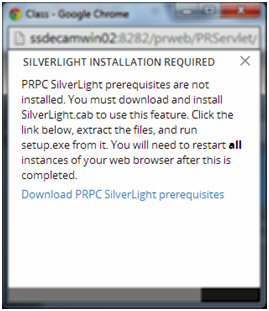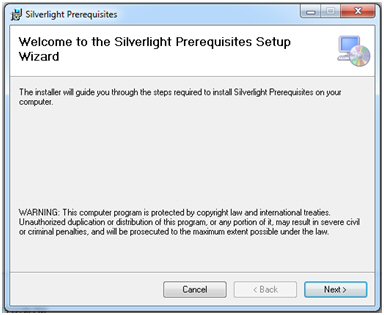Word merge support with Microsoft Silverlight plug-in
Valid from Pega Version 7.1.3
PRPC features that integrate with the Word merge capability are now cross-browser. ActiveX controls (which are only compatible with IE) have been replaced with Microsoft Silverlight. This plug-in must be downloaded separately from Microsoft, as it is not shipped with PRPC.
Some common PRPC features affected by this change include the Application Document Wizard, App Profile, Specifications Landing Page, Specification form, and Case Type Landing Page.
Prior to using these features, Users of PRPC 7.1.3 need to set up their client system(s) as follows:
1. Install Silverlight plug-in
Follow the PRPC prompt to install Silverlight when you attempt to use the Word merge feature:

Or download package directly: www.microsoft.com/silverlight/
2. Install PRPC prerequisites
Microsoft Internet Explorer (IE) browsers automatically detect the need for PRPC prerequisites and will prompt for install:

Non-IE browsers will load a pop-up window when the user attempts to use the Word merge feature. Use the link to manually download PRPC prerequisites:

Extract the .zip file, execute setup.exe and follow the install wizard:

Administrators setting up multiple clients at once may refer to the pzSLpreReqs.cab available in the PRPC 7.1.3 resource kit.
3. Restart browser
Log out of PRPC, close all open sessions and restart your browser.
The PRPC feature integrated with Word merge is now ready for use; Silverlight prompts are no longer displayed.
4. Troubleshooting
Silverlight installation requires access to your file system and a registry setting update to “trust” the associated Verisign certificate. Contact your administrator if you encounter any security or permission errors during this process.
See the PRPC Developer Help for more information on browser setup requirements.
Data Management
Valid from Pega Version 7.1.3
Improvements to data handling were made for the Data Pages, autopopulate properties, and reference properties. Lightweight lists were optimized.
- Property references are now maintained on the Work Page.
- PageList properties can reference a Data Page.
- Auto-populate properties can be used in a seciton to show results from a Data Page.
- Data Pages can run in “Page” mode as well as “List” mode
- The "Rules Not Using Lightweight List" report was enhanced.
- A PageList property that references a Data Page may be used to populate a grid.
- Related autopopulated properties can now be referenced.
Integration
Valid from Pega Version 7.1.3
Usability enhancements have been made to the integration wizards. The REST end-point integration has been improved, and XML parsing functionality has been enhanced.
- PRPC services can return Report or Listview data as XML.
- Work items may now be processed when accessing from a link in system-created emails.
- An SMTP outage will not cause an application to stop working.
- File listener will now read files using a leading asterisk (*).
- XML Parse rule will handle schema validation.
- PegaImageViewer will now work with Version 7.1.
- Security measures are enhanced for SOAP connections to web services.
- After generating rules using REST wizard, the Undo Generation button will delete all the generated rules.
- Email wizard has been improved.
PATCH support for REST integrations
Valid from Pega Version 8.2
REST connectors and REST services now include support for integrating with REST APIs that require using the PATCH method. REST integrations that support the PATCH method allow you to make partial updates to individual resources while retaining data that does not require an update. With PATCH support, you no longer need to write complex custom code to integrate with services that require using the PATCH method.
For more information about REST integrations, see Connect REST form - Completing the Methods tab.
Configure REST connectors for standard-compliant endpoints
Valid from Pega Version 8.2
REST connectors now support all standards-compliant endpoint URLs, regardless of how those URLs use query parameters.
This URL support allows you to do the following actions:
- Include repeated query string parameters in a URL.
- Omit a query string parameter if the value of the parameter is empty when you send a request.
- Apply appropriate encoding for different URL components.
For more information about REST connectors, see Connect REST form.
Elasticsearch reports support string comparison operators
Valid from Pega Version 8.2
To improve performance, reports that use string comparison operators in filters can now run queries against Elasticsearch instead of querying the database. The following operators are now supported for Elasticsearch queries.
- Starts with, Ends with, Does not start with, and Does not end with
- Contains and Does not contain
- Greater than, Less than, Greater than or equal, and Less than or equal
In cases where a query cannot be run against Elasticsearch, the query is run against the database, for example, if the query includes a join. To determine if a query was run against Elasticsearch, use the Tracer and enable the Query resolution event type. For more information, see Tracer event types to trace.
Improvements to email case triaging
Valid from Pega Version 8.2
Improvements to Pega Intelligent Virtual Assistant™ (IVA) for Email make the system more robust and user friendly. When you reply to emails in a triage case, you can forward the email, reply to all, and use the carbon copy (cc) and blind carbon copy (bcc) fields. You can also send Pulse messages to discuss an email case without exposing the information to external users. You are notified in the Email Manager and Case Manager portal if you receive Pulse messages. Even when an email case has been resolved and appears as read-only, you can still send Pulse messages.
For more information, see Email Manager portal and Email triage.
OAuth 2.0 support in Integration Designer
Valid from Pega Version 8.2
Integration Designer now supports the configuration of OAuth 2.0 authentication with authorization code and client credential grant types. Use OAuth 2.0 authentication when creating a new data type, replacing a data source, or updating a data source.
For more information about REST integrations, see About Connect REST rules, and for more information about OAuth 2.0 Authentication, see OAuth 2.0 providers.
Improvements to the Email channel configuration and content analysis
Valid from Pega Version 8.2
To make the Intelligent Virtual Assistant™ (IVA) for Email more useful and easier to manage, you can track all the Email channel configuration changes that you or other operators make. The system now also detects defined entities and topics, not only in the contents of the email messages and its attached files, but also in the email subject field which improves the responsiveness of IVA to emails. You can map same text that appears in an email triage case to different entities. In previous versions of Pega Platform, only the email body was analyzed but with subject analysis, now the entire email is analyzed for topics and entities, including its salutation and signature.
For more information, see Tracking configuration changes in the Email channel and Enabling the analysis of subject field content during email triage.
Facebook and Web Chatbot configuration in the preview console
Valid from Pega Version 8.2
When you develop a Pega Intelligent Virtual Assistant™ (IVA) for Facebook or Web Chatbot, you can now teach interactive bot conversations by chatting with the bot in the preview console and guiding the artificial intelligence algorithm to the right responses. This ability greatly accelerates conversation development and simplifies configuration, while providing the developer with more transparency in the mechanisms that produce specific responses.
For more information, see Simulating a conversation and building a chatbot runtime and Testing and building a chatbot from the preview console.

